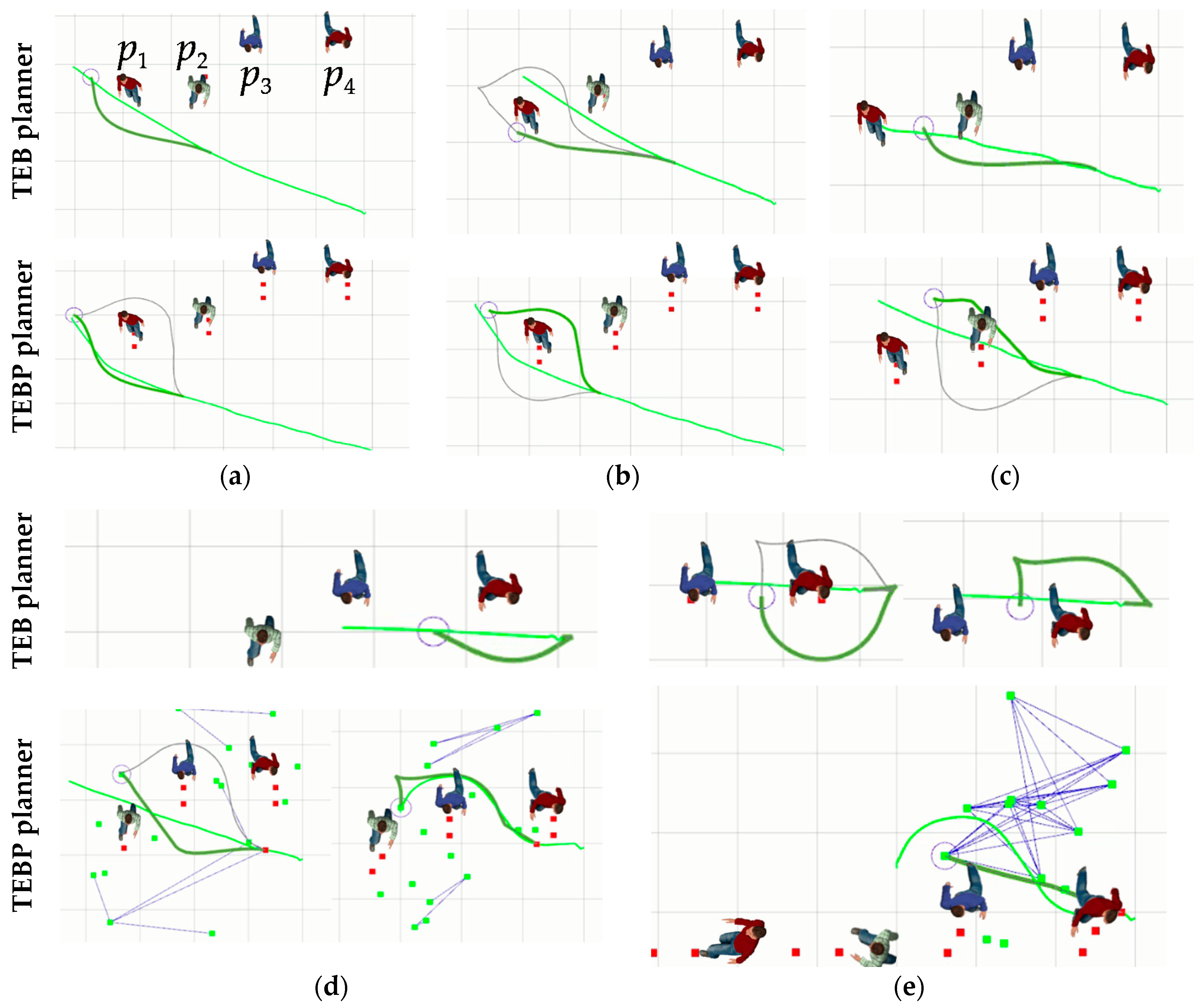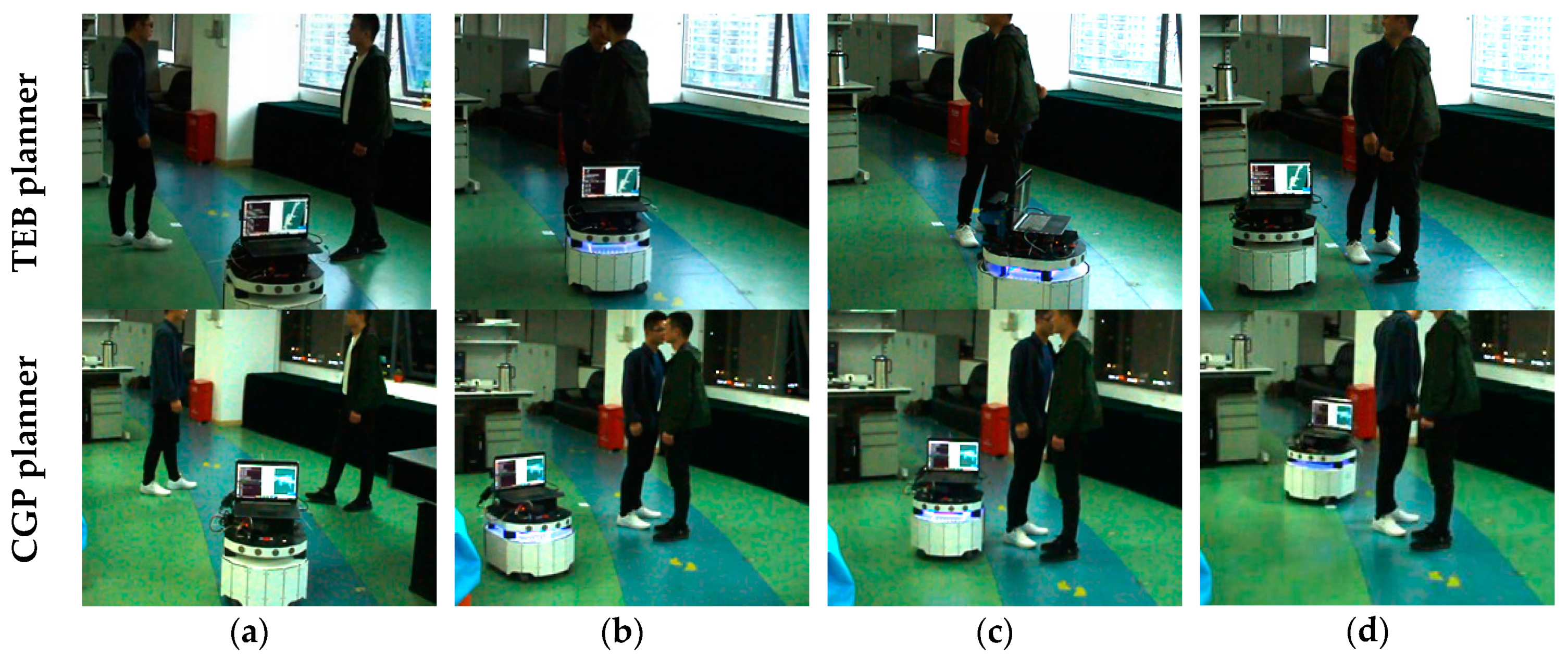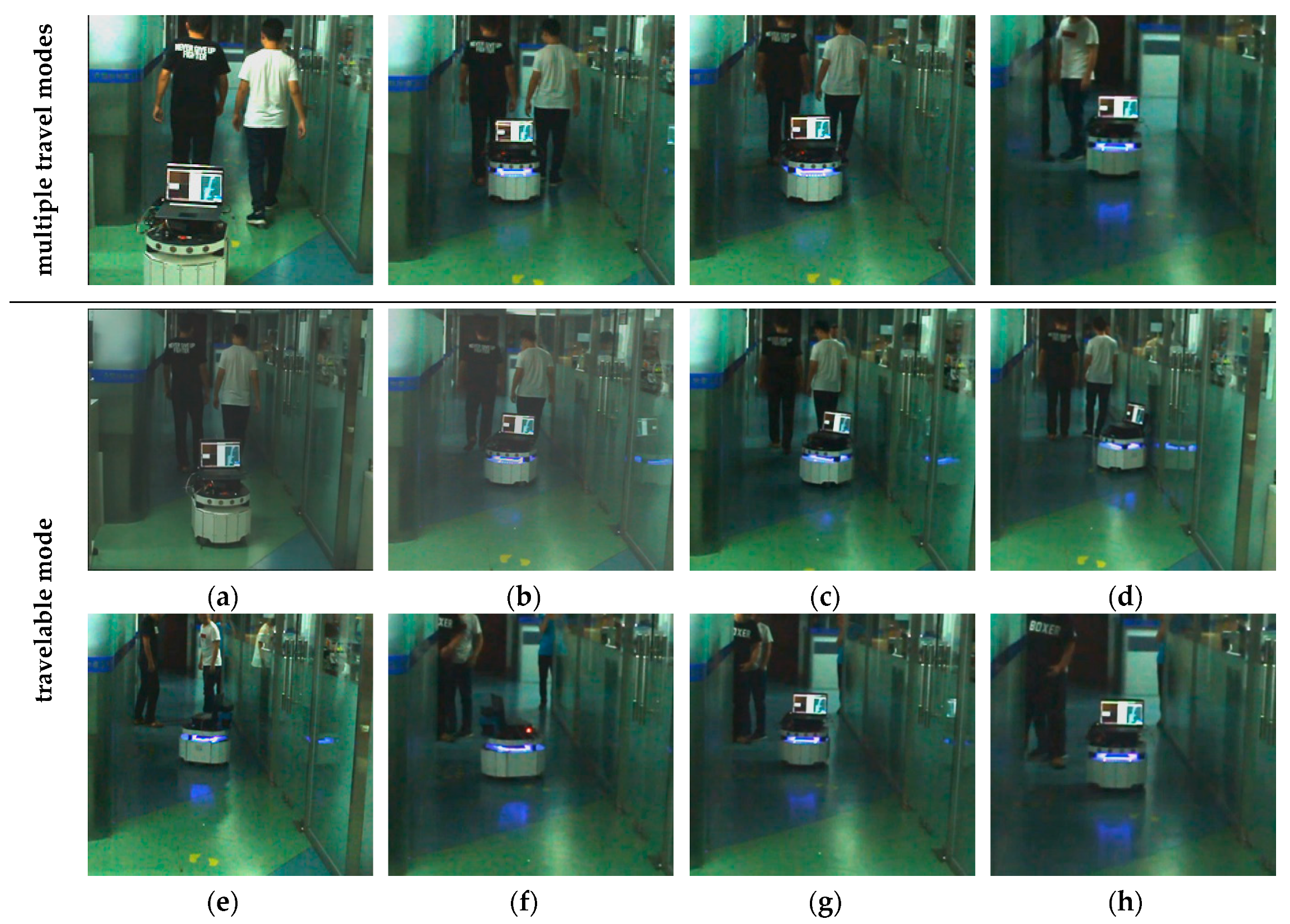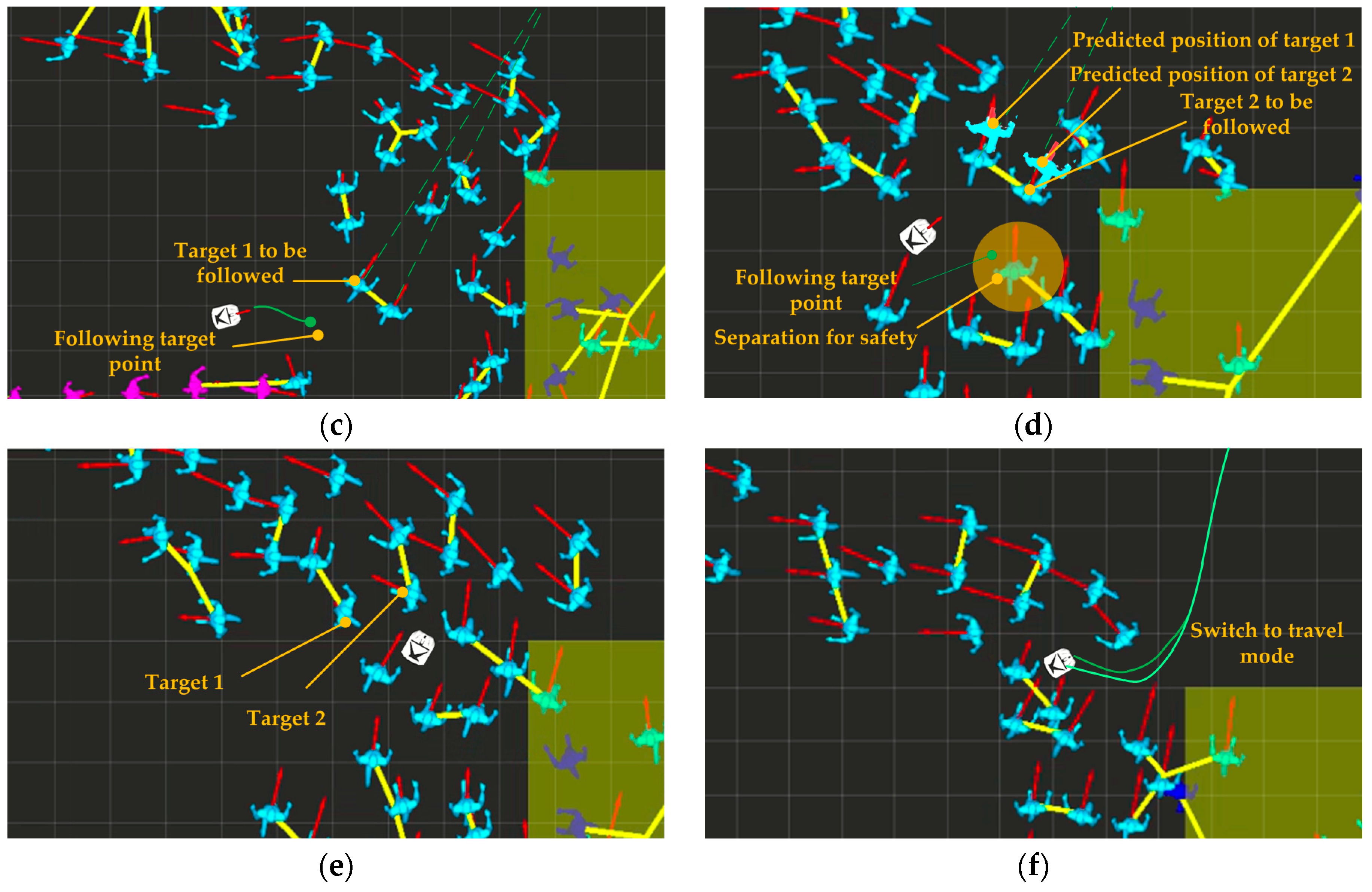Robot Navigation Based on Human Trajectory Prediction and Multiple Travel Modes
Abstract
:1. Introduction
- We present an improved socially conscious model in which a pooled layer between the current pedestrian trajectory sequence input and the pedestrian position estimation layer is added, which models pedestrian trajectories more accurately;
- we present a novel online path planning algorithm that integrates TEB with pedestrians’ predicted movement and feasibility detection, and is capable of generating efficient and safe trajectories in changing crowed space;
- we present multiple modes of travel to guide the robot to find the optimal navigation strategy under changing traffic situations in a crowed area; and
- we demonstrate the proposed algorithms with an experiment in eight scenarios.
2. Methods
2.1. Human Trajectory Prediction with an Improved Socially Conscious Model
| Algorithm 1. Jugement of the effect the relative motion direction of p′ on p |
| 1: if θ∈I and θ < θ’ < 180° then fij[p,p′] = 1 2: elseif θ∈II and θ < θ’ < 180° then fij[p,p′] = 1 3: elseif θ∈III and 180° < θ’ < θ then fij[p,p′] = 1 4: elseif θ∈IV and 180° < θ’ < θ then 1ij[p,p′] = 1 5: else 1ij[p,p′] = 0 |
2.2. Trajectory Detection and Optimization Based on Predicted Pedestrians’ Positions
2.2.1. Local Trajectory for Obstacle Avoidance Optimization Based on Predicted Pedestrian Trajectory
2.2.2. Trajectory Chasing Cost Judgment
- If the pedestrian’s walking speed, 1.2 m/s, the robot will have difficulty to catch up with pi. It is judged as follows (as shown in Figure 4a): The predicted trajectory of pi is extended by 0.7m (safe separation) and intersects with L at point Oi, and the distance between Oi and zs is dri. The robot is assumed to follow L at a speed of 1.2 m/s. If the robot arrives at Oi before pi (as in Equation (8)), the trajectory of Gf(pi) can be chosen.
- If [0.5 m/s, 1.2 m/s], the robot is able to catch up with pi and the judgement method is as follows (as shown in Figure 4b): The robot is assumed to catch up at a speed of 1.2 m/s along with L′ at the angle of π/4 from L, which is along its detection area edge and is the worst case for chasing; similar to the previous method, if the robot catches up successfully (as in Equation (9)), the trajectory of Gf(pi) can be chosen.
- If vpi < 0.5 m/s, the robot will be sure to catch up with pi and any trajectory of Gf(pi) can be chosen.
- If there is a pedestrian, pj, walking towards L behind pi in the robot’s detection area, and the trajectory of Gb(pi) is also of Gf(pj), then the trajectory chasing cost of Gf(pj) is judged according to the above method. If it is successful, the trajectory of Gb(pi) can be chosen; if not, it is confirmed that the trajectory chasing cost of Gf(pj) is too high, and the trajectory of Gf(pj) is unfeasible, then go to the step of judging the trajectory chasing cost of Gb(pj).
- If there is no such pedestrian behind pi, the trajectory of Gb(pi) can be chosen.
2.2.3. The Overall Steps of the Trajectory Planning
- Sample a specified number of waypoints, ζi, that do not intersect with any predicted pedestrians’ occupied zones at t + 0.2 s and t + 0.5 s and obstacle regions by the probabilistic roadmaps (PRM) approach for faster computation [20].
- Construct an exploration graph, G = {V, E}, in which V is the set of vertices that include the robot’s current position, zs; goal point, zg; and waypoints, ζi. E is the set of forward-directed edges that connect waypoint seeds with the orientation close to the direction from zs to zg, and do not intersect with any predicted occupied zones and obstacle regions [15].
- Based on the resulting graph, G, extract each simple path from zs to zg by utilizing a depth-first search.
- Identify the relevant topologies implicated by the predicted pedestrians’ occupied zones and obstacle regions and calculate the H-signature for each resulting path (H-signature for trajectories of the same topology are equal). Only one initial trajectory is reserved for each topology and other trajectories are filtered out.
- Optimize these initial trajectories in parallel by the TEB approach [14], and sort them based on costs from low to high.
- Exclude the trajectories that penetrate groups detected by a modified Density-based spatial clustering of applications with noise (DBSCAN) method [21].
- Judge the chasing costs of trajectories according to the method described in Section 2.2.2. If there is a feasible trajectory, the DATS is in the travelable state, and the first feasible trajectory found is the global optimal trajectory. If there is no feasible trajectory found, that current traffic state is no longer considered to be in the travelable state, and check if there is a low-speed-follow target and safe space ahead.
2.3. Navigation Based on Multiple Travel Modes and Predicted Pedestrians’ Positions
2.3.1. Follow Target Detection and Follow Mode Switching Method for Smooth and Slow-Moving States
2.3.2. Trajectory Planning Strategy for Completely Smooth and Congested States
3. Results and Analysis
3.1. Human Trajectory Prediction
3.2. Trajectory Planning
3.2.1. Validation Experiment with Simulated a Low-Density Crowd
3.2.2. Validation Experiments with a Real Low-Density Crowd
3.3. Navigation Based on Multiple Travel Modes and Predicted Pedestrians’ Positions
3.3.1. Comparation of Navigation with Multiple Travel Modes and with the Travelable Mode Only
3.3.2. Validation Experiment in a Complex Medium-Density Crowd Environment
4. Discussion and Conclusions
Author Contributions
Funding
Conflicts of Interest
References
- Vemula, A.; Muelling, K.; Oh, J. Social attention: Modeling attention in human crowds. In Proceedings of the 2018 IEEE International Conference on Robotics and Automation (ICRA), Brisbane, Australia, 21–25 May 2018; pp. 1–7. [Google Scholar]
- Keller, C.G.; Gavrila, D.M. Will the pedestrian cross? A study on pedestrian path prediction. IEEE Trans. Intell. Transp. Syst. 2014, 15, 494–506. [Google Scholar] [CrossRef]
- Bar-Shalom, Y.; Li, X.R.; Kirubarajan, T. Estimation with Applications to Tracking and Navigation: Theory Algorithms and Software; John Wiley & Sons: Hoboken, NJ, USA, 2004. [Google Scholar]
- Tao, J.; Klette, R. Tracking of 2d or 3d irregular movement by a family of unscented kalman filters. J. Inf. Commun. Converg. Eng. 2012, 10, 307–314. [Google Scholar] [CrossRef]
- Lee, D.; Liu, C.; Liao, Y.-W.; Hedrick, J.K. Parallel interacting multiple model-based human motion prediction for motion planning of companion robots. IEEE Trans. Autom. Sci. Eng. 2017, 14, 52–61. [Google Scholar] [CrossRef]
- Schulz, A.T.; Stiefelhagen, R. A controlled interactive multiple model filter for combined pedestrian intention recognition and path prediction. In Proceedings of the 2015 IEEE 18th International Conference on Intelligent Transportation Systems, Las Palmas, Spain, 15–18 September 2015; pp. 173–178. [Google Scholar]
- Trautman, P.; Ma, J.; Murray, R.M.; Krause, A. Robot navigation in dense human crowds: Statistical models and experimental studies of human–robot cooperation. Int. J. Robot. Res. 2015, 34, 335–356. [Google Scholar] [CrossRef] [Green Version]
- Alahi, A.; Goel, K.; Ramanathan, V.; Robicquet, A.; Li, F.-F.; Savarese, S. Social lstm: Human trajectory prediction in crowded spaces. In Proceedings of the IEEE Conference on Computer Vision and Pattern Recognition, Las Vegas, NV, USA, 26 June–1 July 2016; pp. 961–971. [Google Scholar]
- Song, C.; Chen, Z.; Zhao, B.; Qi, X.; Hu, Y.; Liu, S.; Zhang, J. Human trajectory prediction for automatic guided vehicle with recurrent neural network. J. Eng. 2018. [CrossRef]
- Ravankar, A.; Ravankar, A.; Kobayashi, Y.; Hoshino, Y.; Peng, C.-C. Path smoothing techniques in robot navigation: State-of-the-art, current and future challenges. Sensors 2018, 18, 3170. [Google Scholar] [CrossRef] [PubMed]
- González, D.; Pérez, J.; Milanés, V.; Nashashibi, F. A review of motion planning techniques for automated vehicles. IEEE Trans. Intell. Transp. Syst. 2016, 17, 1135–1145. [Google Scholar] [CrossRef]
- Fox, D.; Burgard, W.; Thrun, S. The dynamic window approach to collision avoidance. IEEE Robot. Autom. Mag. 1997, 4, 23–33. [Google Scholar] [CrossRef] [Green Version]
- Rösmann, C.; Feiten, W.; Wösch, T.; Hoffmann, F.; Bertram, T. Trajectory modification considering dynamic constraints of autonomous robots. In Proceedings of the ROBOTIK 2012—7th German Conference on Robotics, Munich, Germany, 21–22 May 2012; pp. 1–6. [Google Scholar]
- Rösmann, C.; Hoffmann, F.; Bertram, T. Kinodynamic trajectory optimization and control for car-like robots. In Proceedings of the 2017 IEEE/RSJ International Conference on Intelligent Robots and Systems (IROS), Vancouver, BC, Canada, 24–28 September 2017; pp. 5681–5686. [Google Scholar]
- Rösmann, C.; Hoffmann, F.; Bertram, T. Integrated online trajectory planning and optimization in distinctive topologies. Robot. Autonom. Syst. 2017, 88, 142–153. [Google Scholar] [CrossRef]
- Ye, N.; Somani, A.; Hsu, D.; Lee, W.S. Despot: Online pomdp planning with regularization. J. Artif. Intell. Res. 2017, 58, 231–266. [Google Scholar] [CrossRef]
- Bai, H.; Cai, S.; Ye, N.; Hsu, D.; Lee, W.S. Intention-aware online pomdp planning for autonomous driving in a crowd. In Proceedings of the 2015 IEEE International Conference on Robotics and Automation (ICRA), Seattle, WA, USA, 26–30 May 2015; pp. 454–460. [Google Scholar]
- Vemula, A.; Muelling, K.; Oh, J. Modeling cooperative navigation in dense human crowds. In Proceedings of the 2017 IEEE International Conference on Robotics and Automation (ICRA), Singapore, 29 May–3 June 2017; pp. 1685–1692. [Google Scholar]
- Goebel, R.P. Ros by Example; Lulu. com: Morrisville, NC, USA, 2015. [Google Scholar]
- Jaillet, L.; Simeon, T. Path deformation roadmaps: Compact graphs with useful cycles for motion planning. Int. J. Robot. Res. 2008, 11–12, 1175–1188. [Google Scholar] [CrossRef]
- Rösmann, C.; Oeljeklaus, M.; Hoffmann, F.; Bertram, T. Online trajectory prediction and planning for social robot navigation. In Proceedings of the 2017 IEEE International Conference on Advanced Intelligent Mechatronics (AIM), Munich, Germany, 3–7 July 2017; pp. 1255–1260. [Google Scholar]
- Lee, M.C.; Park, M.G. Artificial potential field based path planning for mobile robots using a virtual obstacle concept. In Proceedings of the 2003 IEEE/ASME International Conference on Advanced Intelligent Mechatronics (AIM 2003), Kobe, Japan, 20–24 July 2003; pp. 735–740. [Google Scholar]
- Dauphin, Y.; de Vries, H.; Bengio, Y. Equilibrated adaptive learning rates for non-convex optimization. In Proceedings of the Advances in Neural Information Processing Systems, Montreal, QC, Canada, 7–12 December 2015; pp. 1504–1512. [Google Scholar]
- Pellegrini, S.; Ess, A.; Schindler, K.; Van Gool, L.J. You’ll never walk alone: Modeling social behavior for multi-target tracking. In Proceedings of the 2009 IEEE 12th International Conference on Computer Vision, Kyoto, Japan, 29 September–2 October 2009; pp. 261–268. [Google Scholar]
- Lerner, A.; Chrysanthou, Y.; Lischinski, D. Crowds by example. In Computer Graphics Forum; Wiley Online Library: Hoboken, New Jersey, USA, 2007; pp. 655–664. [Google Scholar]
- Patil, M.; Abukhalil, T.; Patel, S.; Sobh, T. Ub robot swarm—Design, implementation, and power management. In Proceedings of the 2016 12th IEEE International Conference on Control and Automation (ICCA), Kathmandu, Nepal, 1–3 June 2016; pp. 577–582. [Google Scholar]
- Helbing, D.; Molnar, P. Social force model for pedestrian dynamics. Phys. Rev. E 1995, 51, 4282. [Google Scholar] [CrossRef]
- Linder, T.; Arras, K.O. People detection, tracking and visualization using ros on a mobile service robot. In Robot Operating System (ROS); Springer: Berlin, Germany, 2016; pp. 187–213. [Google Scholar]
- Zhong, J.; Cai, W.; Luo, L.; Zhao, M. Learning behavior patterns from video for agent-based crowd modeling and simulation. Autonom. Agents Multi-Agent Syst. 2016, 30, 990–1019. [Google Scholar] [CrossRef]
- Bera, A.; Randhavane, T.; Prinja, R.; Manocha, D. Sociosense: Robot navigation amongst pedestrians with social and psychological constraints. In Proceedings of the 2017 IEEE/RSJ International Conference on Intelligent Robots and Systems (IROS), Vancouver, BC, Canada, 24–28 September 2017; pp. 7018–7025. [Google Scholar]
- LaValle, S.M.; Kuffner, J.J., Jr. Randomized kinodynamic planning. Int. J. Robot. Res. 2001, 20, 378–400. [Google Scholar] [CrossRef]
- Patil, M.; Abukhalil, T.; Patel, S.; Sobh, T. Ub swarm: Hardware implementation of heterogeneous swarm robot with fault detection and power management. Int. J. Comput. 2016, 15, 162–176. [Google Scholar]














| Distribution of Pedestrians in DATS | Traffic State | Travel Modes |
|---|---|---|
| No pedestrians | completely smooth | free mode |
| There are reachable pedestrians approaching the goal point at a high speed | smooth | high-speed-follow mode |
| A travelable trajectory exists | travelable | travelable mode |
| There are reachable pedestrians approaching the goal point at a low speed | slow-moving | low-speed-follow mode |
| There is no feasible trajectory and no target can be followed | congested | probing mode |
| Dataset | Socially Conscious Model | Improved Socially Conscious Model | ||
|---|---|---|---|---|
| ADE Reduction Percentage | FDE Reduction Percentage | ADE Reduction Percentage | FDE Reduction Percentage | |
| ETH-Univ | −5.6% | −4.7% | 0.1% | 1.3% |
| ETH-Hotel | 11.3% | 8.4% | 18.5% | 14.3% |
| UCY-Zara 1 | 8.6% | 9.6% | 14.6% | 13.9% |
| UCY-Zara 2 | 7.2% | 9.2% | 10.0% | 12.7% |
| UCY-Univ | 10.4% | 12.1% | 15.7% | 17.0% |
© 2018 by the authors. Licensee MDPI, Basel, Switzerland. This article is an open access article distributed under the terms and conditions of the Creative Commons Attribution (CC BY) license (http://creativecommons.org/licenses/by/4.0/).
Share and Cite
Chen, Z.; Song, C.; Yang, Y.; Zhao, B.; Hu, Y.; Liu, S.; Zhang, J. Robot Navigation Based on Human Trajectory Prediction and Multiple Travel Modes. Appl. Sci. 2018, 8, 2205. https://doi.org/10.3390/app8112205
Chen Z, Song C, Yang Y, Zhao B, Hu Y, Liu S, Zhang J. Robot Navigation Based on Human Trajectory Prediction and Multiple Travel Modes. Applied Sciences. 2018; 8(11):2205. https://doi.org/10.3390/app8112205
Chicago/Turabian StyleChen, Zhixian, Chao Song, Yuanyuan Yang, Baoliang Zhao, Ying Hu, Shoubin Liu, and Jianwei Zhang. 2018. "Robot Navigation Based on Human Trajectory Prediction and Multiple Travel Modes" Applied Sciences 8, no. 11: 2205. https://doi.org/10.3390/app8112205
APA StyleChen, Z., Song, C., Yang, Y., Zhao, B., Hu, Y., Liu, S., & Zhang, J. (2018). Robot Navigation Based on Human Trajectory Prediction and Multiple Travel Modes. Applied Sciences, 8(11), 2205. https://doi.org/10.3390/app8112205





